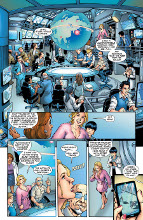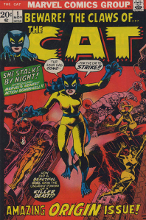
Confessions of a Comic Book Guy is a weekly column by Steve Bennett of Super-Fly Comics and Games in Yellow Springs, Ohio. This week, Bennett looks at how women are portrayed in most comics.
It received nearly zero attention on this side of the Atlantic but there was an interesting comic book-related piece on the UK's Guardian Website last week (well interesting to me, anyway). Written by R.J. Palacio, and titled "Comic-book superheroine Cat aims to see of gender stereotypes," it concerns a new free online comic called My So-Called Secret Identity featuring a young woman named Cat who is a PhD student whose only superpower is intelligence. It's created by Will Brooker, author of the books Batman Unmasked and Hunting the Dark Knight, who "was so horrified at the way women are represented in comics that he decided to write his own antidote." It features a "feminist approach from the ground up, in terms of story, character, artwork and production." The "catalyst" for it was a visit to his local comic book shop:
"I walked in and I just felt so unwelcome. All the comics on the shelves were featuring women as pin-ups--women with their boobs out, or their clothes falling off… If someone like me feels uncomfortable walking into a comic shop, it's no wonder most teenage girls and adult women wouldn't set foot inside one,"
Now while I disagree with Mr. Brooker about women and comic shops (see "Confessions of a Comic Book Guy--The Biggest Danger in America"), I will cop to the fact that comic book shops are awash in objectified, unattainable images of idealized female (and male) anatomy, but then, so is America. Women can also see "women with their boobs out, or their clothes falling off," or worse, on any magazine rack in any "real" book store. And while there are definitely some women who take one look inside a comic book shop and suddenly decide they have to be anywhere else immediately, those are the exceptions to the rule. Sure, we could always do more to make our stores less intimidating to outsiders, to be less of an "ugly boy store," but the truth is most women can take it. I've seen it with my own eyes.
And I do have to admire his efforts to deconstruct the superhero comic genre to see why it doesn’t work for most women. Or as he put it:
"We took everything we hated about superhero comics--and flipped the script," he said, promising "no heroines running in stupid heels. No skimpy costumes or unrealistic proportions. No brainless, bra-less female characters or cheesecake pin-ups. No women as mere love-interest, or victims to be rescued and revenged."
Optics definitely plays its part, but I think it's pretty much universally agreed that the major thing keeping more women from reading more comics is the stories, and how the stories are told. I'd like to see Marvel and DC do some inner reflection on their material, seeing how often they flat out get it wrong even when they have the best of intentions. Like in DC's World's Finest #6 where Power Girl, in the guise of her secret identity, conducts a major business meeting in her fuzzy pink robe. No doubts the author saw this move as being both cute and empowering (she lives life on her own terms!) but the overall effect was wrenching and just plain inappropriate.
My So-Called Secret Identity is available free online and I'll be following its progress because while good intentions are nice, as we've seen, it's the execution of them that matters. Marvel Comics had the best intentions back in 1972 when they published Claws of the Cat. Created by Stan Lee and Marie Severin and in spite of having female writers and a supposedly feminist slant she was clearly designed to appeal first to men. Or, to quote Severin in Wikipedia:
"I remember saying, 'My God, I drew this woman and Wally (Wood) inked her like she's wrapped in Saran Wrap. His storytelling always had lovely inking, nice blacks and everything, but I didn't have her that revealing. The boys loved his work, though.
Sadly Claws of the Cat lasted only four issues (Wikipedia says a fifth was finished, drawn by Ramona Fradon of Brenda Starr fame; please, Marvel, let's finally see this story in print), after which she was split into two different characters, equally problematic when it came to appealing to female readers. Her civilian identity Greer Nelson was transformed into Tigra (a were-tiger in a bikini; 'nuff said) and The Cat costume was gifted to long-time teen-romance character Patsy Walker. She started calling herself "Hellcat," which frankly isn't something a strong female character should really be calling herself (do a quick Google search and see for yourself). And then of course there was that whole business where she married the Son of Satan, went mad, committed suicide and spent time burning in Hell...
The opinions expressed in this column are solely those of the writer, and do not necessarily reflect the views of the editorial staff of ICv2.com.




